ADATA SP920 (128GB, 256GB, 512GB & 1TB) Review
by Kristian Vättö on April 1, 2014 8:30 PM ESTRandom Read/Write Speed
The four corners of SSD performance are as follows: random read, random write, sequential read and sequential write speed. Random accesses are generally small in size, while sequential accesses tend to be larger and thus we have the four Iometer tests we use in all of our reviews.
Our first test writes 4KB in a completely random pattern over an 8GB space of the drive to simulate the sort of random access that you'd see on an OS drive (even this is more stressful than a normal desktop user would see). We perform three concurrent IOs and run the test for 3 minutes. The results reported are in average MB/s over the entire time.
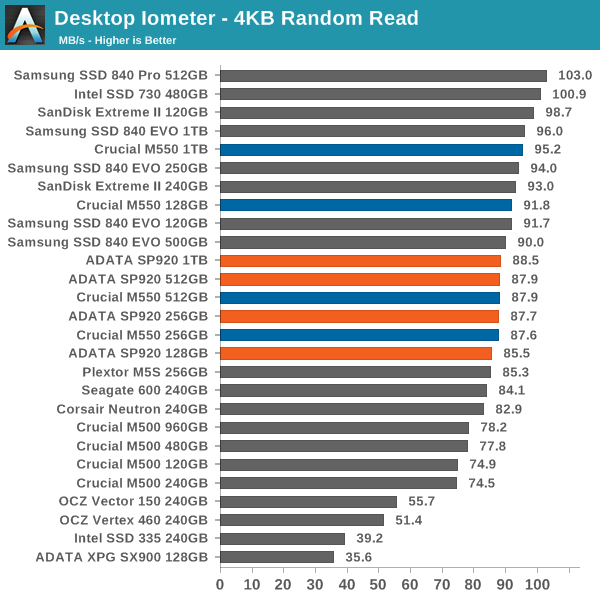
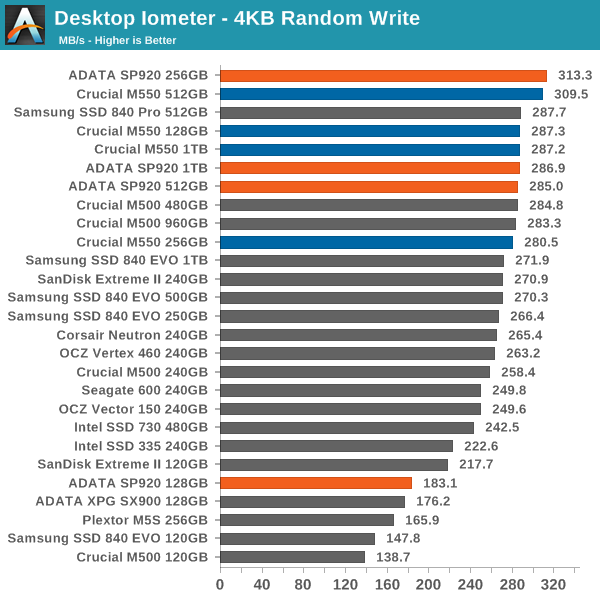
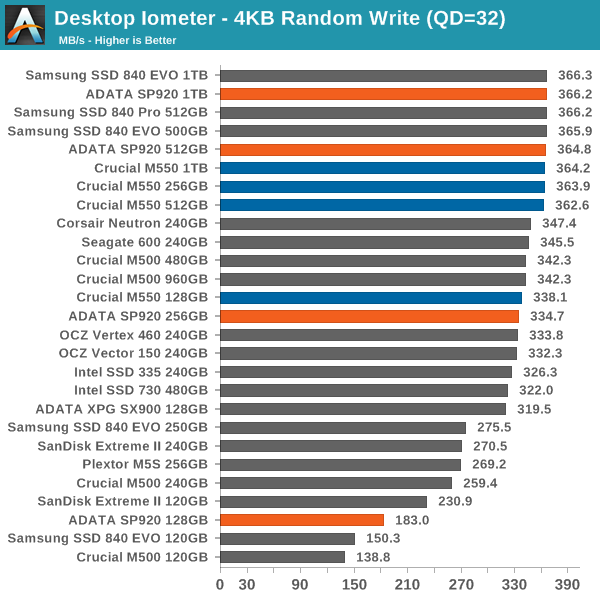
Here you can clearly see the disadvantage of 128Gbit NAND. While the 128GB M550 is nearly able to match the bigger capacities, the 128GB SP920 is noticeably slower. It still offers better performance than a few competing 120/128GB class SSDs, but there are plenty of faster options.
Sequential Read/Write Speed
To measure sequential performance we run a 1 minute long 128KB sequential test over the entire span of the drive at a queue depth of 1. The results reported are in average MB/s over the entire test length. Read speeds tend not to drop as much with fewer NAND die, so the SP920 128GB looks similar to the other SP920 capacities here.
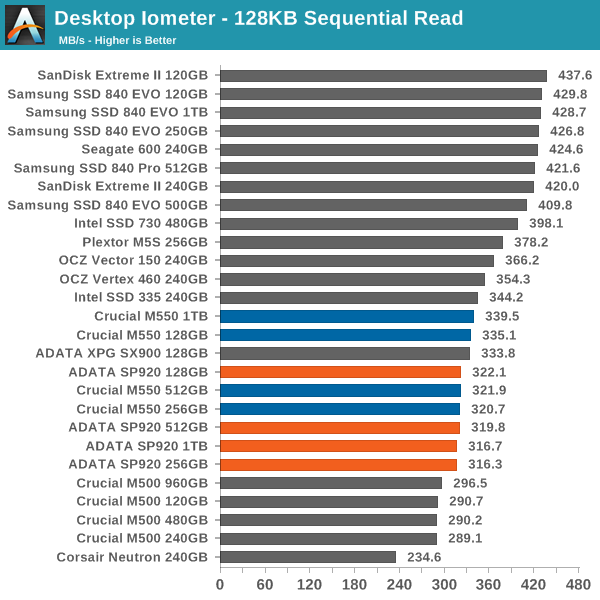
The same isn't true of sequential write performance—at 256GB there is only a minor decrease over bigger capacities but the 128GB offers about half the throughput of the other SSDs.
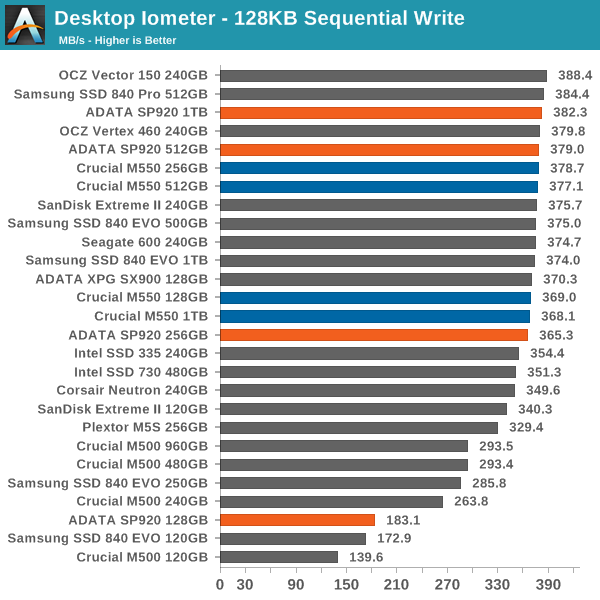
AS-SSD Incompressible Sequential Read/Write Performance
The AS-SSD sequential benchmark uses incompressible data for all of its transfers. The result is a pretty big reduction in sequential write speed on SandForce based controllers. Here, the M550 ends up quite a bit faster than the SP920 at the lower capacities in the write test, though both are still faster than the M500.
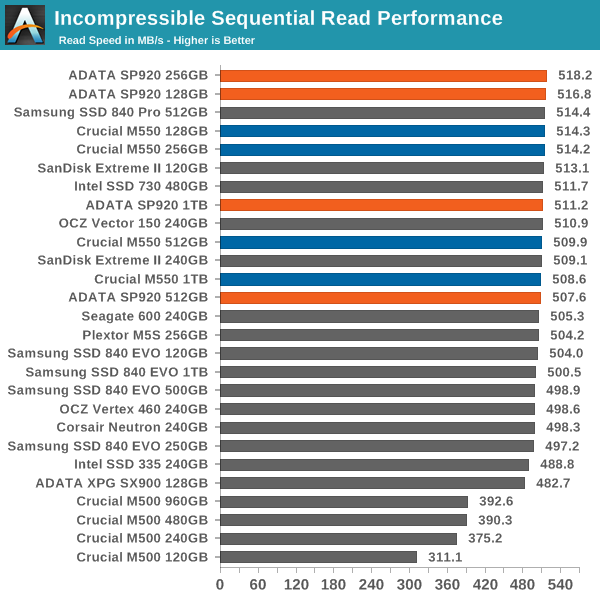
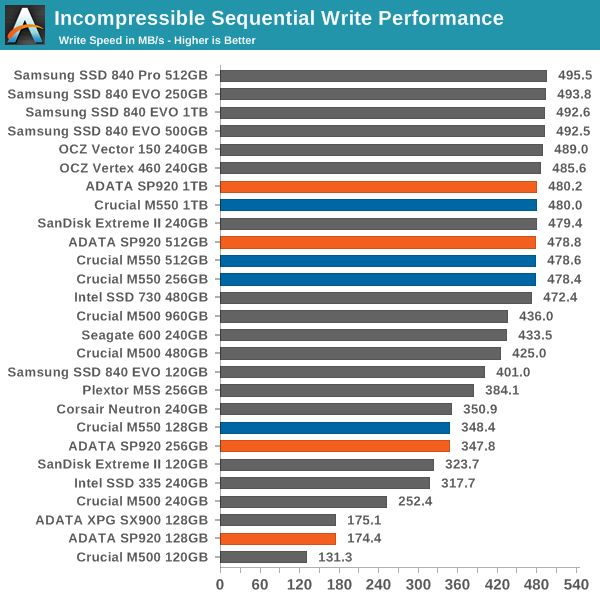










30 Comments
View All Comments
Guspaz - Thursday, April 3, 2014 - link
I agree. I read the whole article more often than not, but on some articles, where I'm pressed for time or don't have the same degree of interest in the subject of the review, I just read the introduction and the final words. As such, getting the gist of the whole article is very important.Heck, even when I do read the whole article, it's still important. Sometimes a good summary at the end points out things that I missed, or gives me a better idea how to interpret the results.
Kristian Vättö - Thursday, April 3, 2014 - link
I've been with AnandTech for three years now, so I'm not exactly new :)Since the SP920 is a rebranded M550, I think it's a must to look at the M550 review as well, which is why I referred to it so much. Now that I look it at, a mention of the SP920's position in the market wouldn't have hurt but as I mentioned in the introduction, our M550 review has broad coverage of that along with plenty of other stuff.
hrrmph - Wednesday, April 2, 2014 - link
Adata claims to have a software toolbox to ease the inconvenience of occasionally needing to do a Secure Erase and other functions. Crucial / Micron doesn't seem to offer that.Samsung offers RAM caching software. Neither Adata nor Crucial / Micron seems to offer that.
hrrmph - Wednesday, April 2, 2014 - link
I would really appreciate it if the hole in the chart could be filled (the Samsung EVO's ratings with 25% spare area).I take it that getting the sample drives from Samsung has been difficult?
Kristian Vättö - Thursday, April 3, 2014 - link
We do have EVO samples (well, Anand has, I don't) but you can see the EVO's OP behavior in the EVO mSATA reviewhttp://www.anandtech.com/show/7594/samsung-ssd-840...
nofly - Friday, April 4, 2014 - link
Will those PCIe drives mentioned in the article be an upgrade option for older motherboards (like a PCIe card) or will new hardware be required ?Kristian Vättö - Friday, April 4, 2014 - link
Most PCIe SSDs in the near future will likely be just regular PCIe cards. Later we may see transition to 2.5" when/if SATA Express becomes a standard.Alientech - Saturday, April 5, 2014 - link
The new ST3000DM001-1E6166 drives with the FC4x firmware seems to be using Shingled Magnetic Recording. Which means we need SSD caching all the more. Sure wish every one would pack one with the drive. With HDD write speeds dropping through the floor now, its a must. Even 250MB write speeds of a SSD is a huge improvement.sammarth - Monday, April 28, 2014 - link
<a href="http://seoexpertzs.wordpress.com">Sammarth... nice thanks for share usgamoniac - Wednesday, May 20, 2015 - link
Hi Kristian, on power consumption, you mentioned you were posting an update with HIPM+DIPM enabled. I searched through AT but didn't find any update. I know this is a year-old article but it would be nice to see that, since there were some SP920 on sales now. It seems like a pretty solid drive with very competitive pricing (256GB for $89 on newegg). Thanks.